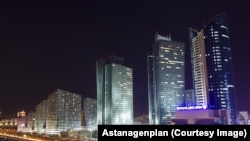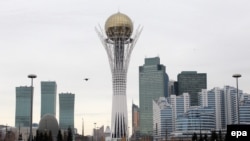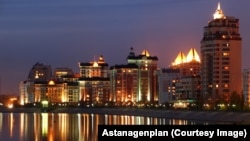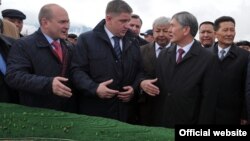
Qishloq Ovozi is pleased to welcome back Nari Shelekpayev, who has already graced our village with a book review titled They Ate The Sheep: The Kyrgyz, From Shepherd To Businessman. This time, Shelekpayev reviews the new book Bienvenue à Astana, La Capitale des Steppes...et du Monde (Welcome To Astana, A Capital Of The Steppe...And Of The World), which looks at the social development and the architecture of Kazakhstan's capital in the steppe.
Since 1997, Kazakhstan’s new capital city, Astana, has attracted quite a bit of attention.
Several factors can explain this: a location deemed exotic by outsiders, phenomenal speed of construction, and incessant publicity each contributing to attract researchers and curious onlookers alike. The newest incomer into this wave, Adrien Fauve, has recently published a book, Bienvenue à Astana, La Capitale des Steppes...et du Monde (Welcome To Astana, A Capital Of The Steppe...And Of The World), which is reviewed here.
The first generation of academic texts dedicated to Astana shared a number of common features. The "internal" discourse remained largely uncritical and mainly perpetuated rhetoric shaped by state authorities. As for ‘Western’ historiography, it either regarded Astana as a case-study on Central Asian authoritarianisms (Astana as Nazarbaev’s product) or inscribed the city into a saga of economic development by a country rich in mineral resources.(1) The above-mentioned approach lingers among the rhetoric of journalists, as a recent article from The Guardian can attest.
That Astana is a product of Kazakhstan’s first and only president is irrefutable. Another undeniable influence from the state consists in its budget, which has partly financed the capital’s construction and is somewhat formed by export incomes. But these factors alone are insufficient in explaining why the governmental district was relocated, and why the city experienced a massive population influx in the late 2000s, shattering all previous predictions of the city’s demographic growth. Such narratives neither explain how people lived, nor how they appropriated the city; its unique proportion of local and global, the role played by transnational actors (chiefly planners and architects) and their ambiguous role in the construction of the capital’s landscape.
Fauve belongs to a new generation of researchers who raised these and other intriguing questions and sought to provide answers to them, backed by social sciences’ methods and theory (chiefly Foucault and Bourdieu). Some of them came to Kazakhstan with a previous knowledge or willingness to learn vernacular languages. As ethnographers, they took their time in acquainting themselves with the city, making local friends, and avoiding the usual cliches upon which a short-term visitor might rely. As a result, in some recent texts, Astana, with all its social and economic effects on "Kazakhstani" society, is finally emerging as an independent object of research instead of being approached solely as a consequence of authoritarianism, geopolitics, oil, and gas.
Fauve defended his doctoral thesis at Sciences Po Paris in 2013; he is now a researcher at the same institution, as well as a guest lecturer at Babes-Bolyai University in Cluj-Napoca in Romania. The book being reviewed is based on his doctoral dissertation. A small pocket edition of 115 pages (with excellent illustrations) was released by the Editions B2 in 2015 and is intended for the larger public. (2)
The book is divided into four main parts that are, in turn, subdivided in smaller chapters. The first section details a short history of Astana, and provides the reasons why it was selected as the capital city of Kazakhstan. This introduction is followed by a description of the main landmarks on the Left Bank of the Ishim River, to where the new governmental district of Astana has moved in the 21st century. The author calls the style of the Left Bank une esthétique de la citation -- an aesthetic of the citation -- a definition that, according to Fauve, conceptualizes the lack of coherence in the new landscape of power in Kazakhstan’s capital. Though the author at times offers details on the clients and contractors, he is chiefly interested in the symbolic meaning of buildings and their role in the construction of both the city and nation’s visionaries.
After a detailed description of the Left Bank, Fauve progresses towards how the master plan of the city (attributed to Japanese architect Kisho Kurokawa) is appropriated and modified by Kazakh planning authorities. This part is mainly based on the analysis of texts and an interview with A. Chikanayev (a former Genplan official) realized in 2010 by the author during his stay in Astana.
Towards the end of the book the author draws insightful connections between the cycling team Astana, the film Borat, and the appearance of Astana. He concludes that Astana’s landscape is actually a part of a larger effort to construct a positive imaginary of the country that the authorities would like to exude in order to improve what the author earlier called "the Borat effect." Such corollary, in spite of its one-sidedness and certain blatancy, reveals that Astana is a showcase not only for "internal" but also for "external" purposes. Fauve chooses to close the book with a question that troubles many at this moment. What will happen with the city after the current president of Kazakhstan leaves power? Shall Astana bear her creator's name?
What legacy will this book leave? It is undoubtedly an entertaining description of contemporary Astana. Construction in the capital is so rapid and precarious, and projects melt into the steppe air so quickly that a portrait of the city might help future readers understand what was there in 2015 and what other people thought it meant. Fauve’s Astana is an urban text, composed of several imposing buildings which mirror and transmit the state, or its sense of self. However, this textual approach is not without its flaws. I will mention two particular issues, one related to the reading of the city and the other to its materiality.
The first issue regards what we consider "Astana." The author never claimed that Astana only consists of the Left Bank.(3) His text, however, mentions the Right Bank casually and gives it almost no interpretative space. Which part of the city to focus on is one’s sovereign choice but, that being said, can the social complexity of Astana be grasped without considering the dichotomy of both banks? The difference between them is obvious: Right Bank is where the top-down "capitality" had to negotiate and adapt itself to the existing cityscape (and the inhabitants who lived there for generations before the arrival of the state administration) instead of being implanted from scratch, as happened across the river. This "innate" dichotomy must not necessarily be seen through a lens of contradiction/contrast, which so far has been the most obvious and popular approach. Neither is the Left Bank to be seen as a happy outcome of an immaculate conception by the state and a great planner, liberating the city from the original sin of its old and graceless Right Bank, as it was depicted later. Rather, and quite prosaically, the two banks complement each other, making Astana what it is now: an official city flanked by a "social" one where most people live. More precisely, "freshmen" buy or rent apartments on the Right Bank, while the new bourgeoisie moves from the "old" to the "new" city. Moving to the Left Bank thus means crossing a social Rubicon, and few can afford both working and living on the Left Bank. It is typical to see thousands of young clerks going from the Right Bank where they live to the Left Bank where they work.
The second issue regards the buildings that play such an important role in the author’s description. Since 1996, many objects of various quality, size, and cost have been built in Astana. A few of them have been conceived by people who are, or consider themselves to be, architects. However, such a situation begs questions related to the extent these buildings could be considered “architecture.” Rather is it not equally important to investigate who was able to build which buildings, how the attribution of the offers was organized, and who competed and won the competitions? Additionally, whether the architects’ concepts were realized entirely and for which reasons did they deviate from the initial proposals also remains an important issue. The lack of transparency in the construction industry in Kazakhstan is evident and the information about it is not easy to get, but without investigating the dynamics and processes that lay behind “architecture,” a pure interpretation of the built landscape risks remaining l’art pour l’art.
Nari Shelekpayev is a lecturer in history and PhD candidate in urban history at the Université de Montréal
(1) The statements of this paragraph are of course a rough generalization. There were a few exceptions.
(2) An academic version of this research must appear in the near future at the Presses Universitaires de Rennes.
(3) Both Right and Left Bank (of the Essil River) are parts of the same city. The newer, recently built part of the city where most governmental buildings are located, is situated on the Left Bank. The older part of the city, where most people live, is situated on the Right Bank.









